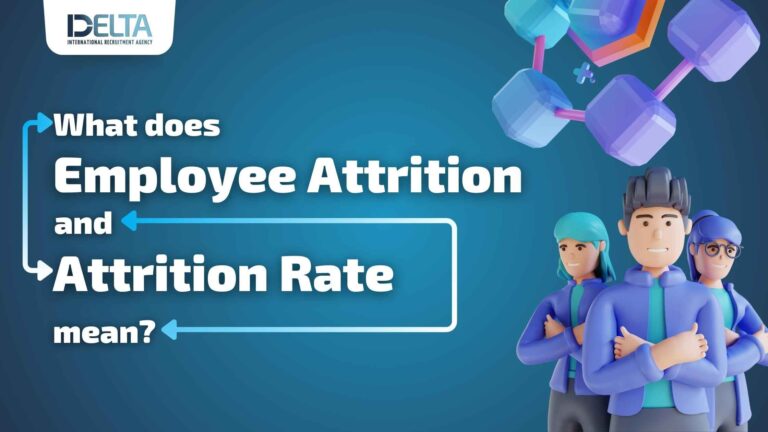Employee attrition and attrition rate are terms that are commonly used in the world of HR and talent management. But what do they actually mean? In this blog post, we will define employee attrition and attrition rate, and explore why these metrics are important for businesses to track. We will also discuss some of the key factors that contribute to employee attrition and provide tips on how to reduce it.
Whether you’re an HR professional for Qatar or a business owner, understanding employee attrition and attrition rate is crucial for maintaining a strong and engaged workforce. So, let’s dive in and demystify these terms once and for all!
What does employee attrition involve?
Employee attrition refers to a slow decrease in your workforce size, brought about by factors like employees resigning for personal or professional reasons.
It’s important not to mix up employee attrition with turnover. While they sound alike, they have distinct differences. Attrition is a gradual process influenced by various unavoidable factors, including planned resignations, retirements, and structural changes. On the other hand, turnover is more immediate and requires prompt attention.
Distinguishing Between Employee Attrition and Turnover
Several inevitable factors contribute to attrition, such as planned resignations, retirements, and structural changes. In contrast, turnover is a more immediate metric that requires immediate attention.
What does the employee attrition rate signify?
It is a metric employed to gauge the number of employees who departed from a company in a given year in relation to the number of new hires.
Difference between Attrition vs Turnover
How to figure out attrition rate?
It’s not as complex as it sounds. Just follow these steps:
- Start with the number of employees you had at the beginning of the year. Let’s say it was 750.
- Note how many employees left during the year. For instance, if 150 left, that’s our number.
- Count how many new employees you brought in by the end of the year. Let’s assume you hired 200, making the total headcount 950.
- Calculate the average number of employees for the year. Using our example, it’s (750+950)/2, which equals 850.
- Now, find the attrition rate. Divide the number of employees who left (150) by the average number of employees (850), and multiply by 100.
For our example: (150/850) x 100 = 17.65%.
In a nutshell, the formula for Attrition Rate is: Number of Attritions / Average Number of Employees x 100.
Why does attrition matter?
High attrition comes with increased costs for the company. The money invested in recruitment for Saudi Arabia, selection, onboarding, and training goes down the drain when employees leave. Additionally, attrition leads to lower productivity, adding more expenses for the company.
Types of Employee Attrition
- Voluntary Attrition:
- Employees choose to leave voluntarily.
- Reasons are often within your control.
- Proactive measures are crucial to retain valuable talent and maintain productivity.
- Involuntary Attrition:
- Initiated by the company.
- Typically linked to employee misconduct or behavioral issues.
- Can occur during mergers and acquisitions.
- Internal Attrition:
- Employees move from one department to another within the same company.
- Usually beneficial for better employee-job fitment.
- Investigate if a department consistently experiences internal attrition.
- Demographic Attrition:
- Employees from a specific group (ethnic minorities, veterans, women, etc.) leave in large numbers.
- Critical concern for equal-opportunity workplaces.
- Resolve through surveys, identifying root causes, and implementing solutions.
- Retirement:
- Attrition due to retirement is typically small.
- High retirement numbers can impact attrition rates.
- Monitor older professionals leaving early for reasons beyond age.
Causes of Employee Attrition
- Recruitment Error:
- Employees leaving shortly after joining may be due to a recruitment error.
- This happens when the employee wasn’t the right fit for the job.
- Personal Motivation:
- Changes in personal life or goals can lead employees to change or leave their jobs.
- Examples include changes in a child’s school, residence, or spouse’s job.
- In such cases, attrition becomes inevitable
- Workplace Challenges:
- A major cause of voluntary attrition.
- Challenges range from poor leadership to a lack of necessary tools for work.
- Professional Motivation:
- Employees may leave if they perceive a lack of opportunities for learning and career advancement.
- Frustration in achieving career goals can lead to the belief that better prospects exist elsewhere, prompting employees to leave.
Image Source: zavvy.io
Reducing Attrition: Strategies for Success
- Ensure the Right Job and Culture Fit During Hiring: Assess alignment between the job role and cultural values during the hiring process.
- Offer Learning and Development Opportunities: Provide avenues for employees to enhance their skills and advance their careers.
- Promote Real-Time Feedback: Encourage ongoing communication for immediate and constructive feedback.
- Competitive Compensation: Ensure salaries are competitive and in line with industry standards.
- Conduct Thorough Exit Interviews: Gather detailed insights through comprehensive exit interviews.
- Equip Managers for Effective Leadership: Provide managerial training to foster effective leadership.
- Cultivate a Happy and Productive Culture: Foster a positive and productive workplace environment.
Understanding Your Company’s Attrition Rate: Pros and Cons
Tips of Jobs Seekers: What does Employee Attrition and Attrition Rate mean?



